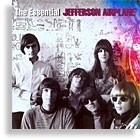
Jefferson Airplane released eight studio albums between 1966 and ’72, then culled a live curtain call from its final tour before morphing into Jefferson Starship. Since then, there have been at least twice that many anthologies and compilations of the original band’s work. While not perfect, RCA/Legacy’s The Essential Jefferson Airplane provides a decent introduction to the band at an affordable price.
The main problem with the two-disc set is the same as with so many other so-called “greatest hits” and “best of” collections. Instead of picking the best, most important material, labels invariably offer what are, in actuality, career overviews (which are not the same thing) – spreading the tracks across the entirety of an artist’s or group’s catalog. But even if that were the aim, short-changing the band’s debut, Jefferson Airplane Takes Off (which gets three tracks to five each from Surrealistic Pillow and Volunteers), is not only questionable, it’s unnecessary. Disc one clocks in at less than 50 minutes, while more than 78 minutes are packed onto disc two. A half-hour could have been added to the first disc!
Takes Off may not have shot to #1, but it was a landmark album, and at the time the Airplane was easily the focal point of San Francisco’s Fillmore/Avalon scene – considerably bigger than the Dead or Quicksilver or Country Joe & The Fish. The 1966 album is represented here by “Blues From An Airplane,” “It’s No Secret,” and “Come Up the Years.” I can’t argue with any of those inclusions, but would add Paul Kantner’s rocking “Let Me In,” original female vocalist Signey Anderson’s solo vehicle, “Chauffeur Blues,” and the group’s recording of “Let’s Get Together,” which predated the Youngbloods’ hit version. There was a certain folkie charm to that maiden flight, and Jack Casady’s bass playing was nothing short of revolutionary.
By the time Surrealistic Pillow was released a year later, rhythm guitarist Kantner and leader/vocalist Marty Balin remained, along with the adventurous bass/guitar tandem of Casady and Jorma Kaukonen, but Anderson left to start a family and guitarist-turned-drummer Skip Spence returned to his original instrument and formed Moby Grape. They were replaced by Grace Slick and Spencer Dryden, respectively. Justifiably, the sophomore effort, which produced two hit singles, merits five songs here; I’d actually add three more. “Somebody To Love” and “White Rabbit” (both Slick vehicles) are givens, as are Balin’s poetic ballad, “Comin’ Back To Me,” Kaukonen’s acoustic tour de force, “Embryonic Journey,” and “She Has Funny Cars.” But “Today” is another example of Balin’s pop melodicism, and while “Plastic Fantastic Lover” and “3/5 Of A Mile In 10 Seconds” show up in live incarnations on disc two, comparisons with their original studio versions would be illuminating.
While the more psychedelic After Bathing At Baxter’s (released only 10 months after Pillow) reflected the changes that had occurred over the Summer Of Love, Balin’s pop sensibility was missing, as most of the songs were penned by Kantner or Slick – one exception being Jorma’s “Last Wall Of The Castle,” featuring his distinctive hummingbird vibrato and some flame-thrower fuzz.
The group’s sound continued to get heavier, and while Kaukonen and Casady continued to shine, the songs weren’t as strong. Eventually, Jorma and Jack left to concentrate on what was originally a side project, Hot Tuna. For a mini time capsule, this is a good place to start. But I highly recommend the remastered versions of the first two albums.
This article originally appeared in VG‘s Aug. ’05 issue. All copyrights are by the author and Vintage Guitar magazine. Unauthorized replication or use is strictly prohibited.


